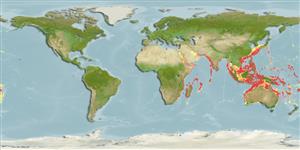Common names from other countries
Classification / Names / Names
ชื่อสามัญ | ชื่อพ้อง | Catalog of Fishes (gen., sp.) | ITIS | CoL | WoRMS
Environment: milieu / climate zone / depth range / distribution range
นิเวศวิทยา
เกี่ยวกับหินโสโครก; ระดับความลึก 3 - 15 m (Ref. 8294). Tropical
Indo-West Pacific: West to Red Sea; north to Japan, east to Vanuatu; south to Australia.
Length at first maturity / ขนาด / น้ำหนัก / Age
Maturity: Lm ? range ? - ? cm Max length : 50.0 cm COLD เพศผู้/กระเทย; (Ref. 269)
Colonies form mounds up to 50 cm in diameter that may dominate large patches of reef. The colonies are composed of thin tubes (the "organ pipes"), 0.2 cm diameter in length, cemented together by horizontal plates at intervals of several centimeters. In life, the corals have white polyps that may cover the corallum. The skeleton is deep red (Ref. 269).
Maximum depth from Ref. 123855. Abundant in mid-shelf reefs, becomes prolific at a depth of 20 m. Less common in muddy coastal areas (Ref. 101098). Common from the reef flat to intermediate depths (Ref. 296).
Life cycle and mating behavior
วัยเจริญพันธุ์ | การสืบพันธุ์ | การวางไข่ | เซลสืบพันธ์ของเพศเมีย(ไข่) | ความดกของไข่ | ตัวอ่อน
Members of the class Anthozoa are either gonochoric or hermaphroditic. Mature gametes are shed into the coelenteron and spawned through the mouth. Life cycle: The zygote develops into a planktonic planula larva. Metamorphosis begins with early morphogenesis of tentacles, septa and pharynx before larval settlement on the aboral end.
Ross, M.A. and G. Hodgson. 1981. (Ref. 8294)
IUCN Red List Status (Ref. 130435)
CITES status (Ref. 108899)
Not Evaluated
Human uses
การประมง: ผลประโยชน์ที่น่าจะเกิดขึ้น
| FishSource | ทะเลรอบๆเรา
เครื่องมือ
แหล่งที่มาจากอินเตอร์เน็ต
Estimates based on models
Preferred temperature
(Ref.
115969): 11.5 - 23.7, mean 17.4 (based on 629 cells).
Vulnerability
Moderate vulnerability (40 of 100).
Price category
Unknown.
